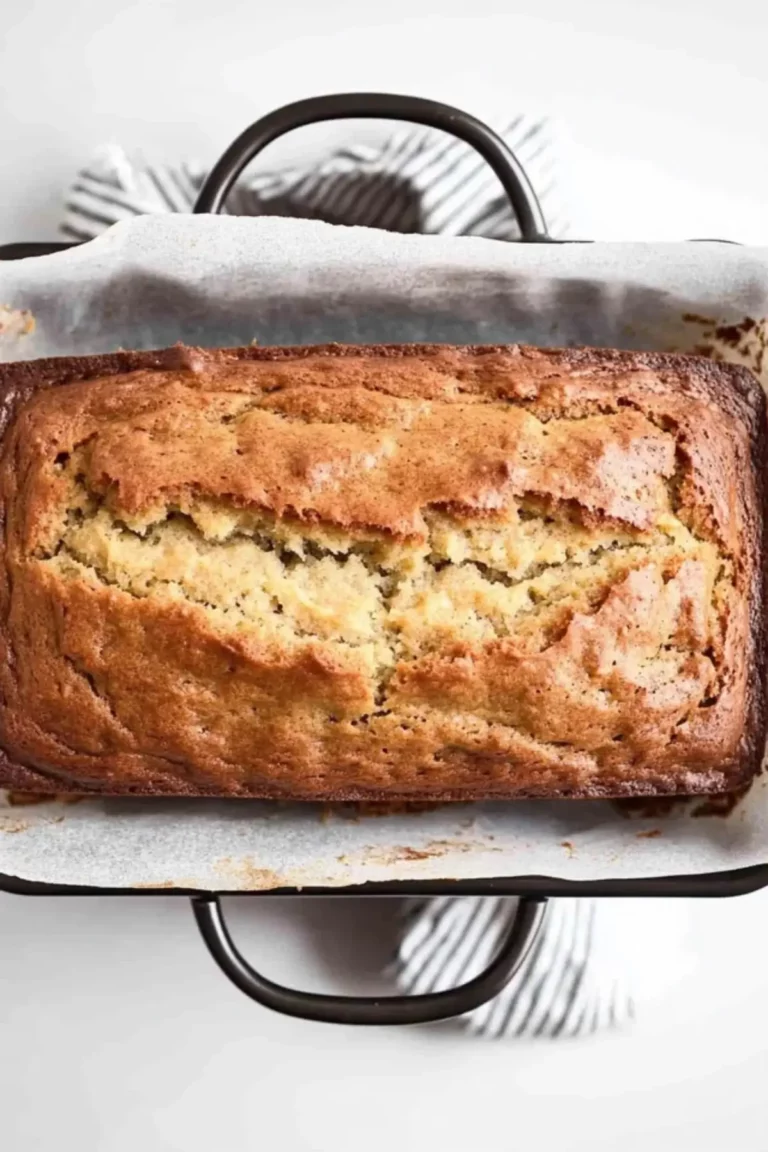The aroma of freshly baked bread is one of the most comforting scents in a home kitchen. I still remember the first time I made a homemade baguette—it was intimidating at first, but once I took my first bite of that crusty, golden loaf with a soft, airy interior, I was hooked. There is something magical about transforming just four simple ingredients—flour, water, yeast, and salt—into a perfect French baguette.
For beginner bakers, this no-knead baguette recipe is a game-changer. Traditional Baguette can be tricky, requiring precise kneading and long fermentation times. However, this method simplifies the process without sacrificing texture or flavor. With just a little patience and minimal effort, you can achieve bakery-quality bread right in your own kitchen.

Why This Recipe is Special
- No kneading required: Unlike traditional bread recipes, this dough develops its gluten structure naturally over time.
- Only four ingredients: No need for special additives or enhancers—just basic pantry staples.
- Perfectly crispy crust: The steam bath in the oven creates that signature crackly crust.
- Great for meal planning: You can bake multiple loaves and freeze them for later.
- Beginner-friendly: Even if you’ve never made bread before, you’ll succeed with this foolproof method.
Ingredients and Their Role
- All-purpose flour – Provides the structure and body of the bread. If you want a chewier texture, bread flour is a great alternative.
- Water – Hydrates the dough and activates the yeast. Using lukewarm water helps the fermentation process.
- Yeast – The key to the bread’s rise and airiness. Both active dry yeast and instant yeast work for this recipe.
- Salt – Enhances flavor and helps control the yeast fermentation.
Alternative Ingredient Suggestions
- Flour Variations: Use bread flour for a chewier texture or whole wheat flour for a heartier, more rustic baguette.
- Yeast Substitute: If using fresh yeast, dissolve it in warm water before adding it to the flour.
- Salt Adjustments: Reduce or increase the salt slightly to match your taste preference.
Step-by-Step Instructions
Step 1: Prepare the Dough
In a large mixing bowl, combine flour, yeast, and salt. Slowly add lukewarm water while stirring with a wooden spoon until all the flour is incorporated. The dough will be sticky and shaggy, which is completely normal. Cover the bowl with plastic wrap and let it rest at room temperature for 12-20 hours. This long fermentation allows the dough to develop deep flavor and an airy texture.
Step 2: Shaping the Baguettes
The next day, generously flour your hands and your work surface. The dough will be very soft and sticky, so handle it gently. Divide it into 2-3 equal portions and carefully shape each into a long, thin baguette (about 12 inches long). Place the shaped dough onto a floured baking sheet or a baguette pan.
Step 3: Second Rise
Cover the baguettes with a clean kitchen towel and let them rest in a warm place for 1-2 hours. This step allows the dough to rise again and become even airier.
Step 4: Preparing for Baking
Preheat the oven to 450°F (230°C). Place a deep baking pan filled with hot boiled water on the bottom rack of the oven—this creates steam, which helps the baguettes develop a crispy crust.
Step 5: Scoring and Baking
Using a very sharp knife, score the top of each baguette with 2-3 diagonal slashes. This helps the bread expand properly during baking. Place the baking sheet on the middle rack and bake for 10 minutes with the water pan in place.
Step 6: Finishing the Bake
After 10 minutes, carefully remove the water pan and continue baking for another 30 minutes or until the baguettes turn golden brown and crisp.
Step 7: Cooling and Serving
Once done, remove the baguettes from the oven and let them cool on a wire rack for at least 15 minutes before slicing. This allows the structure to set properly and prevents the bread from becoming gummy inside.

Beginner Tips and Notes
- Dough Too Sticky? That’s normal for a high-hydration dough. Flour your hands and work surface generously.
- Flat Baguettes? Ensure you shape the dough tightly into a long, narrow log. Proper shaping keeps the structure intact.
- Hard Crust? For a softer crust, wrap the baguettes in a kitchen towel immediately after baking.
- Storing Baguettes: Store in a paper bag at room temperature for up to 2 days. For longer storage, freeze in an airtight bag and reheat in the oven at 350°F (175°C) for 5-10 minutes.
Serving Suggestions
This homemade baguette is incredibly versatile. Here are some of the best ways to enjoy it:
- Classic French Style: Serve warm with European-style butter or high-quality olive oil.
- Smoked Salmon Dip: Pair with a creamy salmon spread for an elegant appetizer.
- Steak Sandwiches: Slice the baguette and fill it with grilled steak, caramelized onions, and arugula.
- Bruschetta: Top with fresh tomatoes, basil, and balsamic glaze for a refreshing snack.
- Soups & Stews: Perfect alongside a bowl of homemade soup like French onion or tomato bisque.
Conclusion
Making homemade baguettes may seem daunting at first, but with this easy no-knead method, anyone can achieve bakery-quality results. Whether you’re a beginner or a seasoned home baker, this recipe is a great way to develop your bread-making skills.
Give it a try and let us know how it turns out! If you have any questions or need troubleshooting tips, drop a comment below. Happy baking!
FAQ About Homemade Baguette
Why is my baguette dough so sticky?
A high-hydration dough, like this one, is naturally sticky. This hydration is key to achieving a soft, airy interior. To handle it more easily, generously flour your hands and work surface or lightly wet your hands before shaping the dough.
Can I use bread flour instead of all-purpose flour?
Yes! Bread flour has a higher protein content, which will give your baguettes a slightly chewier texture. If using bread flour, you may need to add a little more water to achieve the same hydration level.
Why are my baguettes flat instead of tall and airy?
Flat baguettes often result from under-proofing, over-proofing, or improper shaping. Ensure the dough rises for the recommended time and that you shape it tightly into a narrow log. Also, check that your yeast is fresh and active.
More Relevant Recipes
- Yogurt Flatbreads. 2 basic ingredients. So easy & ready in minutes!
- Rustic Italian Crusty Bread
- FOCACCIA

Baguette (The Easiest Recipe)
- Total Time: 1 hour 5 minutes (plus resting time)
- Yield: 2–3 baguettes 1x
- Diet: Vegetarian
Description
This easy no-knead baguette recipe delivers bakery-quality results with minimal effort. Featuring a crispy golden crust and a soft, airy interior, this French-style bread is perfect for beginners. With only four ingredients and an overnight rise, this foolproof method creates a delicious homemade baguette without any kneading.
Ingredients
- 6 cups all-purpose flour (adjust if needed based on brand)
- 3 cups lukewarm water
- 2 teaspoons yeast
- 2 teaspoons salt
Instructions
- Prepare the Dough: In a large mixing bowl, combine the flour, yeast, and salt. Slowly pour in the lukewarm water while stirring with a wooden spoon. Mix until the ingredients are well incorporated and form a shaggy, sticky dough. Cover the bowl with plastic wrap and let it rest at room temperature for 12-20 hours to allow slow fermentation and gluten development.
- Shape the Baguettes: Generously flour your hands and work surface. Gently turn out the sticky dough and divide it into 2-3 equal portions. Lightly stretch and fold each portion into a long, narrow baguette shape, about 12 inches long. Transfer to a floured baking sheet or baguette pan, ensuring the dough is evenly shaped.
- Let the Dough Rise: Cover the shaped baguettes with a clean kitchen towel and place them in a warm spot to rise for 1-2 hours. The dough should puff up and appear lighter, but should not double in size completely.
- Prepare for Baking: Preheat the oven to 450°F (230°C). Place a deep baking pan filled with hot boiled water on the bottom rack of the oven to create steam. This will help the baguettes develop a crisp, golden crust.
- Score and Bake: Use a very sharp knife to make 2-3 diagonal slashes on the top of each baguette. This allows the bread to expand properly while baking. Place the baguettes in the middle rack of the oven and bake for 10 minutes with the steam pan in place. After 10 minutes, carefully remove the water pan and continue baking for another 30 minutes, or until the baguettes are golden brown and crispy.
- Cool and Serve: Remove the baguettes from the oven and transfer them to a wire rack to cool for at least 15 minutes before slicing. This resting time allows the structure to set and prevents the inside from becoming gummy. Serve warm with butter, olive oil, or as a side to your favorite meals.
Notes
- If the dough is too sticky, lightly wet your hands instead of using excessive flour.
- For a softer crust, wrap the warm baguettes in a clean kitchen towel after baking.
- To freeze, wrap cooled baguettes in plastic wrap and store in a freezer-safe bag for up to 3 months. Reheat directly in the oven.
- Whole wheat flour can be used for a denser, nuttier variation, but may require additional water.
- Prep Time: 25 minutes
- Cook Time: 40 minutes
- Category: Bread
- Method: Baking
- Cuisine: French
Nutrition
- Serving Size: 1 slice
- Calories: 230 kcal
- Sugar: 1g
- Sodium: 392mg
- Fat: 1g
- Saturated Fat: 1g
- Unsaturated Fat: 0g
- Trans Fat: 0g
- Carbohydrates: 48g
- Fiber: 2g
- Protein: 7g
- Cholesterol: 0mg






